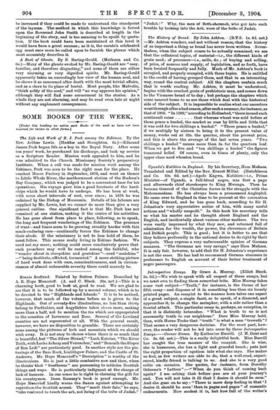The History of Bread. By John Ashton. (R.T.S. is. 64.
net.) —Mr. Ashton wonders, and not without reason,.that the history of so important a thing as bread has never been written. Never- theless, when the subject comes to be actually examined, we see that the collateral topics, of material—i.e., the different kinds of grain used; of processes-'-i.e., mills, &c.; of buying and selling, of price, of sources and supply, of legislation, and so forth, have been treated frequently and fully. Much of M Ashton's book is occupied, and properly occupied, with these topics. He is entitled to the credit of having grouped them, and that in an interesting way, round the central subject.' All the chapters contain much that is worth' reading. Mr. Ashton, it must be 'understood, begins with the crushed grain of prehistoric man, and comes down to the Viennese bread of to-day ; but perhaps the chapters which come nearest home to us are those which deal with the historical side of the subject. It is impossible to realise what our ancestors went through after a bad season, after such a summer, for instance, as that of 1903. "In 1289," according to Holinshed, "there insued such
continuall raine that whereas wheat was sold before at three pence a bushel, the market so rose by little and little that it was sold for two shillings a bushel." "Three pence a bushel," if we multiply by sixteen to bring it to the present value of money, works out at 328. the quarter, about the present price, and this is above the average of the last seven years. "Two shillings a bushel" means more than 3s. for the quartern loaf. When we get to five and "ten shillings a bushel" the figures transcend belief. Of course, even in times of plenty, only the upper class used wheaten bread.






































































 Previous page
Previous page